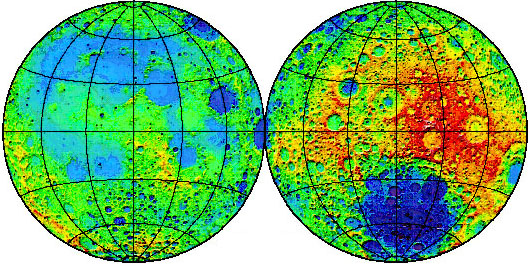Chang’E-1 Orbiter Is Blazing a New Trail in China’s Planetary Exploration

A huge amount of scientific data has been accumulated by the Chinese CE-1 lunar orbiter. In response to worldwide attention to the Chang’E-1 lunar mission, a series of technical papers authored by Chinese scientists are published in the new special Vol.39 Issue 10 of “Science in China Series G: Physics, Mechanics & Astronomy” on October 20, 2009, and in Vol. 54 Issue 20 of the “Chinese Science Bulletin”, to report on China’s new discoveries in lunar science, as well as new tracking techniques developed for deep space exploration.
Using CE-1 laser altimeter (LAM) data, Jinsong Ping and Qian Huang et al obtained improved 3D lunar topography, and based on this, they had made new discoveries (such as impact basins and volcanic deposit highlands) of some ancient topographic characteristics on the lunar surface. Chao Chen and Qing Liang et al found the South Pole-Aitken (SPA) basin as the biggest mascon on the moon and put forward a fault structure hypothesis for the Apenninue Mountain, which is significant for the study of the origin and evolution of the moon. This special-issue papers reporting on the Chang’E selenodesy results were jointly accomplished by experts from the Shanghai Astronomical Observatory (SHAO), the China University of Geosciences (Wuhan) and other institutions.
Based on the CE-1 lunar DEM model CLTM-s01 published in 2008, researchers from SHAO took a comparative planetary science approach and successfully found some impact basins (i.e. the quasi-impact basin Sternfeld-Lewis and impact basin—Fitzgerald-Jackson) and one crater (i.e. the crater-Wugang) on the far side, and one middle scale volcanic deposit highland (i.e. the 2800m highland-Yutu) on the nearside. Moreover, they analyzed and identified some middle scale impact basins and classified them according to their circular characteristics. Based on the Bouguer gravity anomaly, researchers from the China University of Geosciences confirmed that the South Pole-Aitken (SPA) basin is the biggest mascon on the terrestrial planets in the solar system. Comparing the Apenninue Mountain of the moon with the Himalayas on the earth, they put forward a hypothesis about the possible existence of a big fault structure band, which would possibly change our previous knowledge that there is no motion in the interior of the moon.
The research was supported by the Lunar and Mars exploration missions in China. It was also funded by the “Hundred Talent” project and the National Science Foundation of China (NSFC No. 10973031), as well as the Key Direction Research Program KJCX2-YW-T13-2 of the Chinese Academy of Sciences. The acquired valuable results have established a solid foundation for future investigation in the lunar topographic characteristics and evolution of basins.
Download attachments: